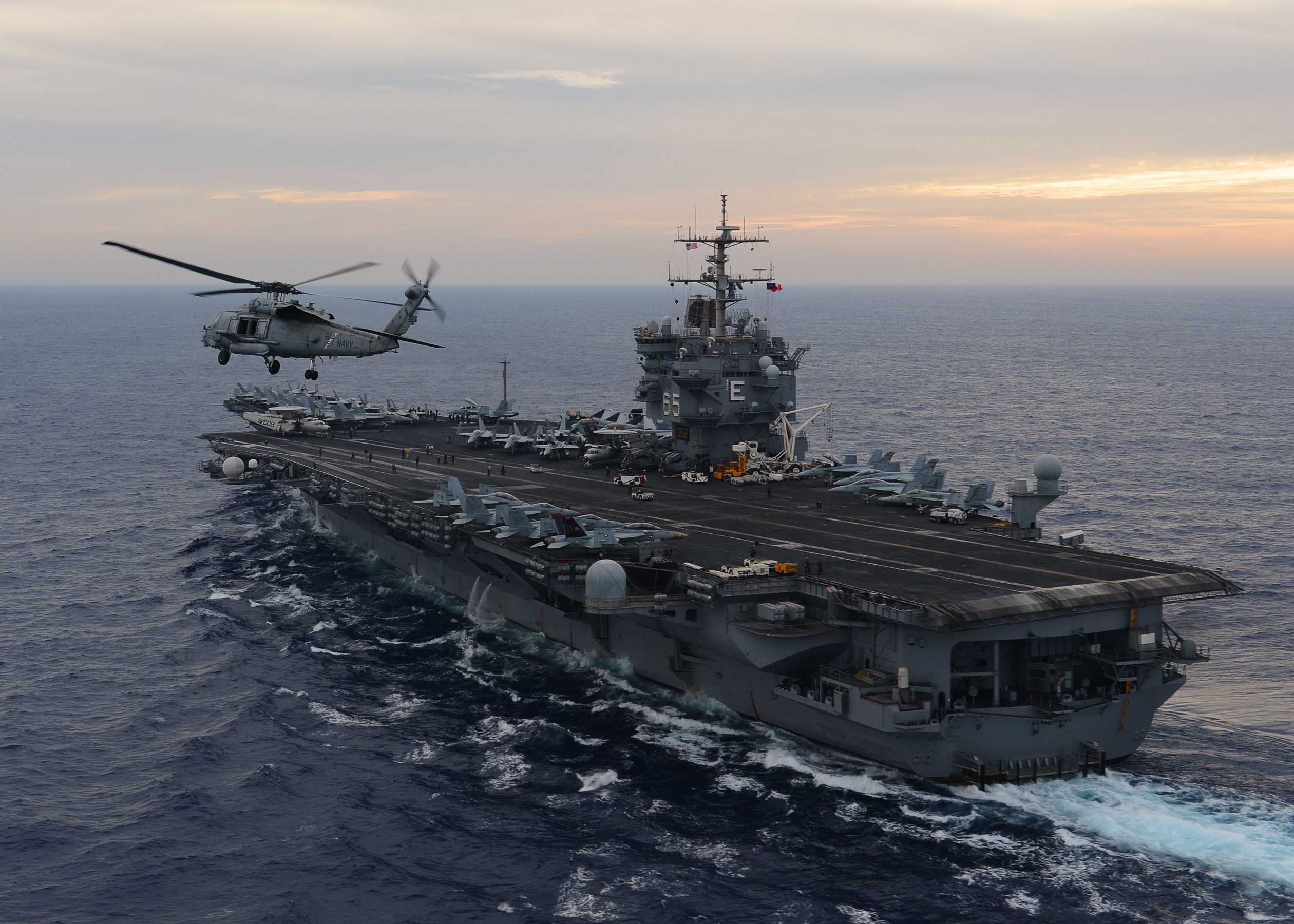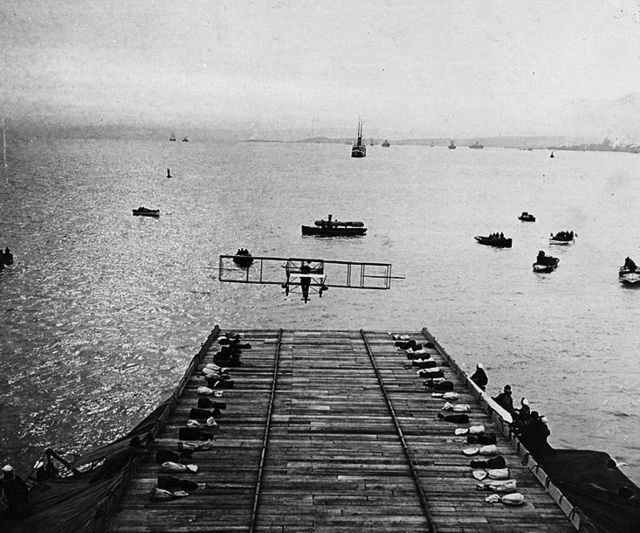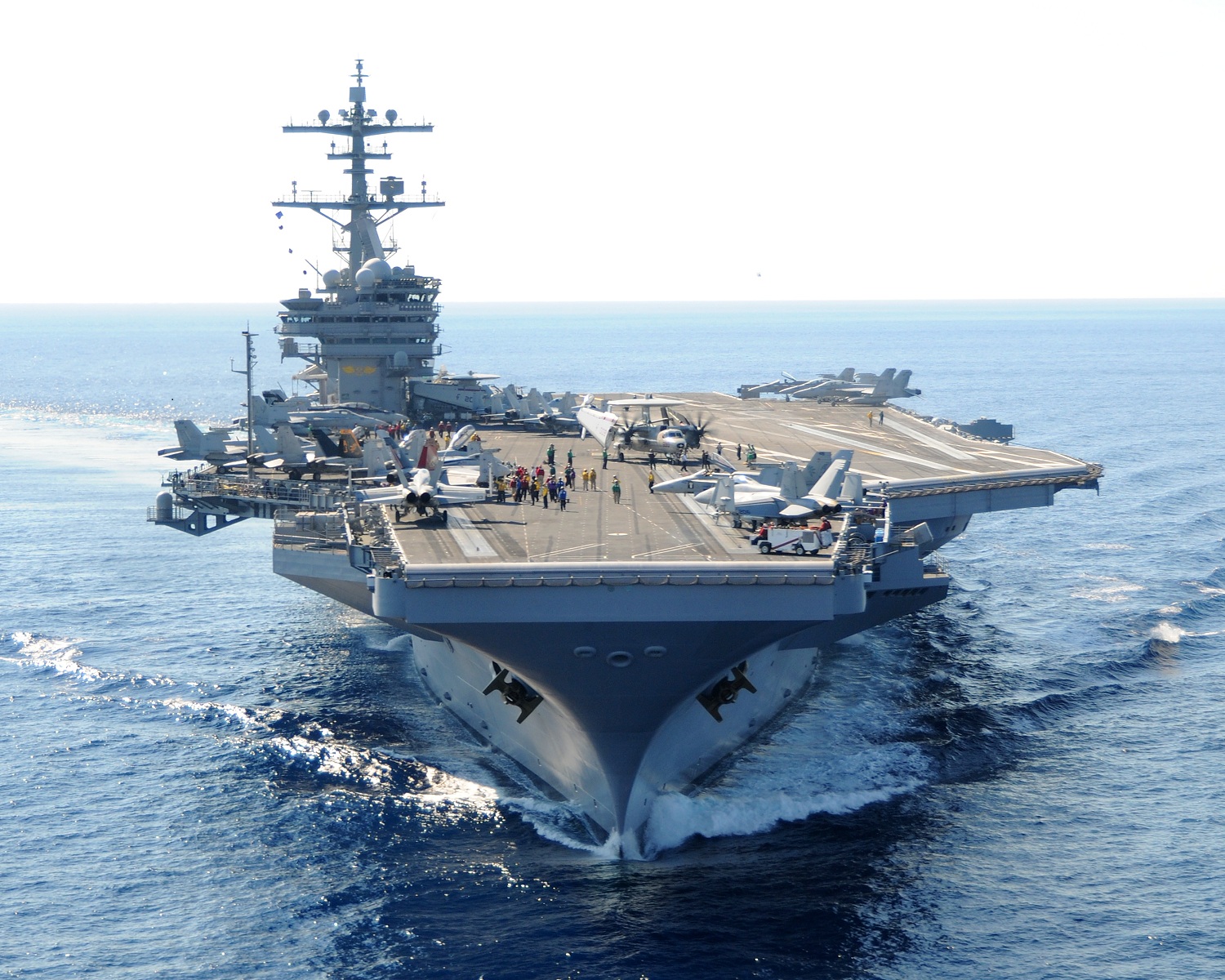

An HH-60H Sea Hawk helicopter assigned to the Dragonslayers of Helicopter Anti-submarine Squadron (HS) 11 flies above aircraft carrier USS Enterprise (CVN 65), the world's first nuclear-powered aircraft carrier. (U.S. Navy photo by Mass Communication Specialist 3rd Class Scott Pittman)
During the third and final presidential debate and in response to Romney's comments on possible military cuts and to Romney's contention that the U.S. Navy today has fewer ships than it did in 1917, Obama informed Romney -- making the point that our powerful, modern weapons systems cannot be compared, in numbers or capabilities, to our weapons of yore -- that "we also have fewer horses and bayonets," and that "we have these things called aircraft carriers, where planes land on them... "
It is not the first time that Romney has made such nonsensical claims.
During the Jan. 16, 2012, Republican presidential debate, Romney said:
"The most extraordinary thing that's happened with this military authorization is the president is planning on cutting $1 trillion out of military spending... Our Navy is smaller than it's been since 1917. Our Air Force is smaller and older than any time since 1947. We are cutting our number of troops. We are not giving the veterans the care they deserve. We simply cannot continue to cut our Department of Defense budget if we are going to remain the hope of the Earth. And I will fight to make sure America retains military superiority."
While Romney makes several claims here, Politifact focused on two of Romney's claims: one of them being his claim that "our Navy is smaller than it's been since 1917" and concludes:
"This is a great example of a politician using more or less accurate statistics to make a meaningless claim. Judging by the numbers alone, Romney was close to accurate. In recent years, the number of Navy and Air Force assets has sunk to levels not seen in decades, although the number of ships has risen slightly under Obama.
However, a wide range of experts told us it's wrong to assume that a decline in the number of ships or aircraft automatically means a weaker military. Quite the contrary: The United States is the world's unquestioned military leader today, not just because of the number of ships and aircraft in its arsenal but also because each is stocked with top-of-the-line technology and highly trained personnel.
Thanks to the development of everything from nuclear weapons to drones, comparing today's military to that of 60 to 100 years ago presents an egregious comparison of apples and oranges. Today's military and political leaders face real challenges in determining the right mix of assets to deal with current and future threats, but Romney's glib suggestion that today's military posture is in any way similar to that of its predecessors in 1917 or 1947 is preposterous.
In addition, Romney appears to be using the statistic as a critique of the current administration, while experts tell us that both draw-downs and buildups of military equipment occur over long periods of time and can't be pegged to one president. Put it all together and you have a statement that, despite being close to accurate in its numbers, uses those numbers in service of a ridiculous point. Pants on Fire." (emphasis mine)
Politifact also quotes an expert -- William W. Stueck, a historian at the University of Georgia -- saying, "Counting the number of ships or aircraft is not a good measurement of defense strength because their capabilities have increased dramatically in recent decades." The expert adds that Romney's comparison "doesn't pass 'the giggle test."
Almost prophetically, Politifact noted nine months ago:
"Still, most experts we spoke to felt that Romney's critique was misguided. [Charles] Knight [co-director of the Project on Defense Alternatives at the Massachusetts-based Commonwealth Institute,] went so far as to offer this reply:
'If Mr. Romney wants a truly stark example of diminished military capability, he should compare today's horse cavalry to that in 1917, or even 1941 when there were still 15 active horse-cavalry regiments in the Army. Today there has been total disarmament of horse cavalry,' he might say, 'leaving our nation defenseless in this regard.' His chosen comparisons are almost as absurd.'"
Just to put naval matters and history into perspective, the photo below shows a young pilot, 24-year-old Eugene B. Ely making the world's first successful aircraft landing on a ship, the cruiser USS Pennsylvania, in San Francisco Bay, on Jan. 18, 1911.

And, below, the Nimitz class USS George H. W. Bush (CVN 77), the newest of the 10 largest aircraft carriers in the world powered by two nuclear reactors and four shafts, capable of carrying and launching more than 60 aircraft, brimming with multiple NATO Sea Sparrow, Phalanx CIWS, and Rolling Airframe Missile (RAM) mounts and other weapons systems.

In a study, the Federation of American Scientists says:
"A carrier with its complement of 50 strike aircraft can deliver more than 150 strikes a day against littoral targets, the prime responsibility of the US Navy. However, should the need arise, relatively long range targets can be attacked. A carrier normally stocks over 4,000 bombs. The Navy plans to upgrade the current tactical airwing from F/A-18Cs and F-14s to a combination of F/A-18C/E/Fs to an all F/A-18E/F airwing and, ultimately, an airwing composed of both F/A-18E/F and a Navy version of the Joint Strike Fighter (JSF)."
Quite a difference from 1916, or even 1960.
And what do the naval shipbuilders have to say about Romney's alarming comments?
According to the Washington Post, "it seemed to hardly make a ripple" in the Navy-heavy region of Hampton Roads:
"In more than a dozen interviews, shipbuilders and Navy families -- Republicans and Democrats alike -- mostly said Obama was just stating the obvious: Numbers aren't the whole story when it comes to naval power.
'Some of the things we put out in the water can do what two ships used to do,' said Arthur Fladger, 55, a nuclear refueler at Newport News Shipbuilding.
Ernie Smith, a 32-year-old engineer at the same shipyard, said, 'A modern ballistic submarine, you can shoot a nuclear missile halfway around the world.'"
Photos and Nimitz statistics are courtesy of the Department of Defense/Department of the Navy public information sites.
